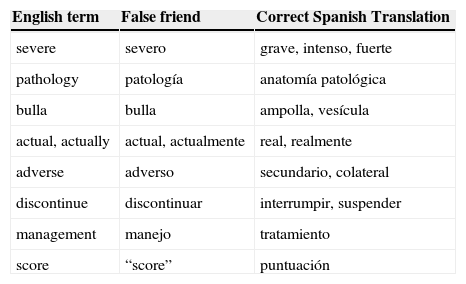The correctness of the writer's medical language has always been one of the parameters used to measure the quality of scientific texts. To clearly convey the intended message without giving rise to confusion or error, medical language must be precise and meticulous.1,2 Language errors have, however, become increasingly common since, as doctors, we are not exactly devotees of the study of language, its rules, or of the errors that have crept in as a result of the incursion of English into our scientific language, for the most part since 1950.3,4
The language we use in dermatology makes use of loan translations (calques) taken from English. In many cases, the words or terms used exist in Spanish, but their meaning is not the same as that intended by the author (Table 1).4 For example many writers in Spanish habitually use the word severo as a translation of the English word severe, creating terms like dermatitis atópica severa and acné severo.
Examples of Translation Errors Caused by False Friends in English.
| English term | False friend | Correct Spanish Translation |
|---|---|---|
| severe | severo | grave, intenso, fuerte |
| pathology | patología | anatomía patológica |
| bulla | bulla | ampolla, vesícula |
| actual, actually | actual, actualmente | real, realmente |
| adverse | adverso | secundario, colateral |
| discontinue | discontinuar | interrumpir, suspender |
| management | manejo | tratamiento |
| score | “score” | puntuación |
Adapted from: Benavent and Iscla.4
The dictionary of the Real Academia Española (the Spanish language academy) defines the adjective severo as follows: “riguroso, áspero, duro en el trato o castigo; exacto y rígido en la observancia de una ley, precepto o regla; dicho de una estación del año, que tiene temperaturas extremas”5 (“strict, tough, harsh in treatment or punishment; precise and rigid in the application of a law, rule or precept; said of a season that has extreme temperatures”). The first of these three meanings of severo is the most common, and it is used to describe the character of a person.
The Spanish term extranjerismo refers to words that have their origin in a foreign language; if the language of origin is English we call them anglicismos.3 Foreign words and phrases have been accumulating in our language for centuries, and it is estimated that 73% of Spanish words today are of Latin origin, while the remaining 27% come from other languages.4 For a foreign word to be accepted and become a neologism, that is, a new element in the language, two basic conditions must be met: there must be a need (in that no other word exists in the language to express the meaning of the neologism); and there must be euphony (the neologism must fit in harmoniously and adapt to the rules of the target language).3,4 Since the term severo does not fulfill the conditions, it is not a neologism, but rather a homophone borrowing or false friend.4 An interesting point is that the acceptance of borrowings and calques by users is affected by a number of factors, including the degree of contact between the two languages. Thus, in areas where there is greater contact with English, we find more English terms in medical language as a result of interference.6 Looking at a concordance extracted from a reference corpus for Spanish7 we see that the use of morphological variants of “sever*” in texts about health care is widespread (1453 cases in this corpus). These variants are found primarily in texts from Latin American countries, such as Venezuela and Mexico, where the influence of English is greater and the two languages are in closer contact (Fig. 1). However, in all these cases the term can be replaced by another adjective in Spanish, and it is the noun modified by the adjective severe that will determine the most appropriate collocate, taking into account Spanish semantics and lexical combinations. For example, casos severos can be replaced by casos graves and espasmo severo can be expressed as espasmo intenso.
Fernando A. Navarro has described the phenomenon of the unnecessary loan translation of the term severe to severo and has also explained how the English word can have multiple translations in Spanish and why the calque severo should not be used.8,9 Very often, the most apt translation of severe is the Spanish word grave: for example, in a severe condition translates as en estado grave and severe trauma can be rendered traumatismo grave. However, contrary to what some people believe, grave is not the only possible translation of the English term severe. The English word can have other meanings, which can be rendered by taking advantage of the lexical richness of our language.8,9 In fact, the use of other translations—including intenso and fuerte—is more common in dermatology. The following are just a few examples: intenso, itching is severe (el prurito es intenso) or severe dyspnea (disnea intensa); extenso, severe psoriasis (psoriasis extenso) or severe rash (erupción cutánea extensa); and avanzado, severe melanoma (melanoma avanzado).8 Moreover, there are other translations that should be adapted to the context; for example, severe acne (acné noduloquístico).4
Therefore, the increasingly common use of the adjective severo in Spanish is not a valid justification for its use as a substitute for Spanish adjectives that would result in a clearer, more accurate, and more scientifically rigorous text.
Please cite this article as: Blasco-Morente G, Garrido-Colmenero C, Tercedor-Sánchez J, Tercedor-Sánchez M. El falso amigo: «severo». Actas Dermosifiliogr. 2015;106:525–526.






